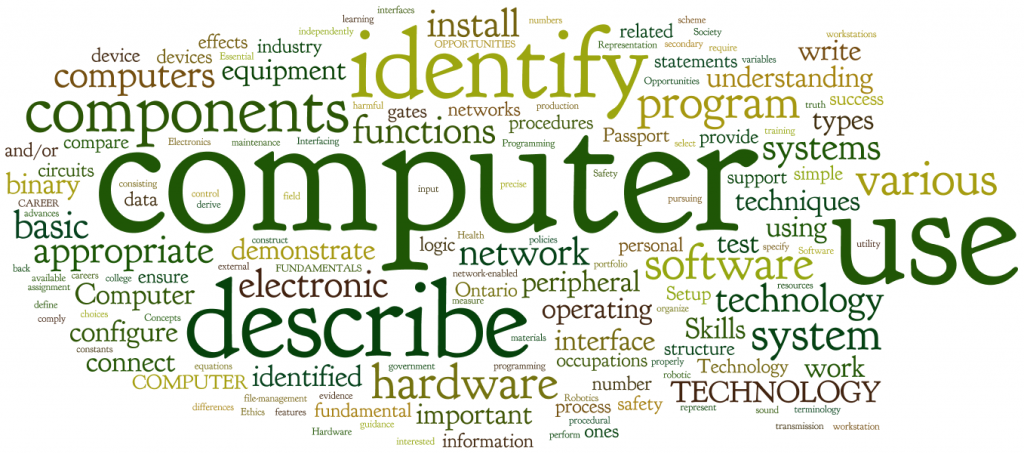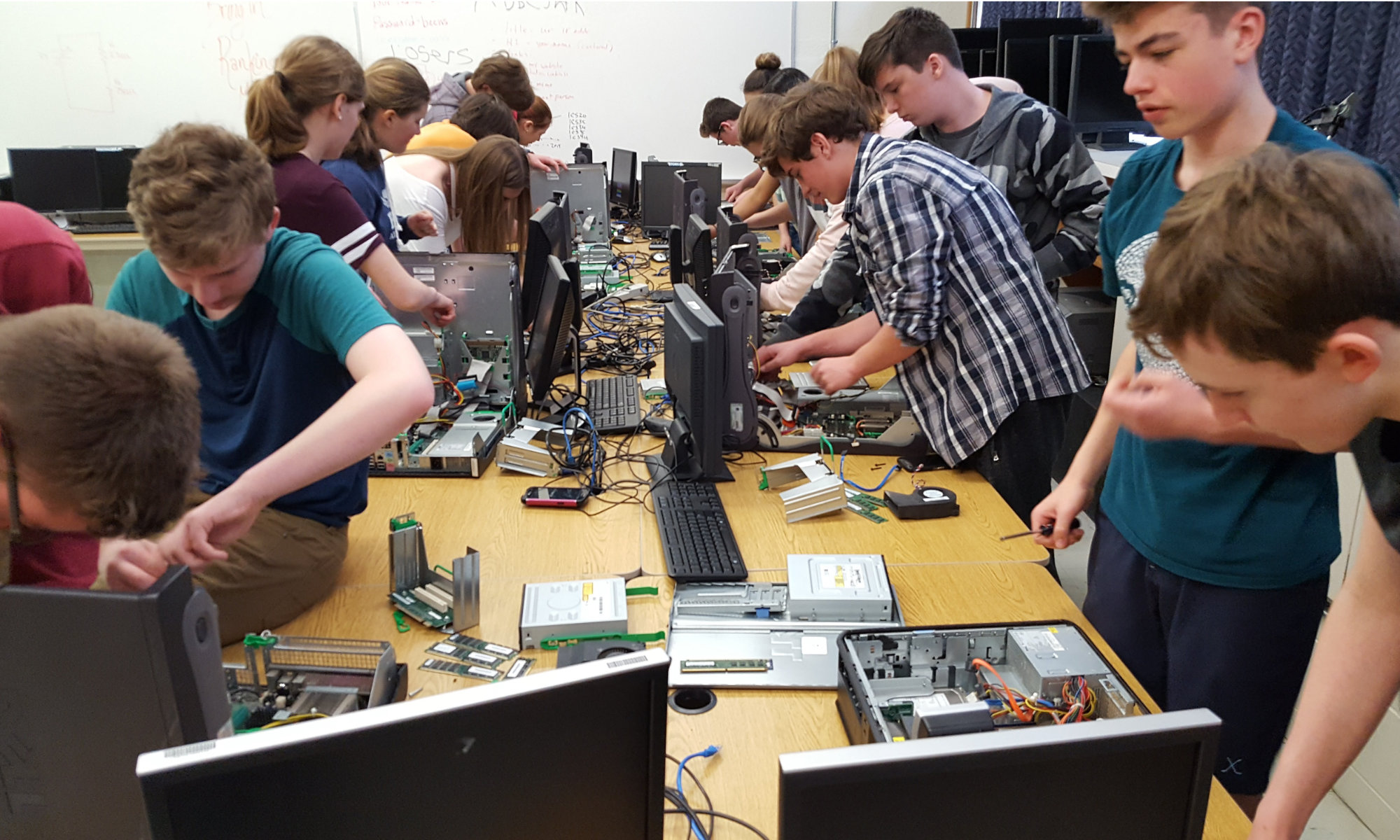The full curriculum with overall expectations and examples is available here.

A. COMPUTER TECHNOLOGY FUNDAMENTALS
OVERALL EXPECTATIONS
A1. identify and describe the functions of, as well as important advances related to, electronic and computer components;
A2. demonstrate a basic understanding of computer networks and their components;
A3. demonstrate a basic understanding of binary numbers and digital logic.
A1. Computer Hardware
A1.1 identify basic electronic components and describe their functions;
A1.2 use precise terminology to identify various types and features of computer hardware and interfaces;
A1.3 identify the basic components and peripheral devices of a computer system, and describe their functions;
A1.4 describe important advances in electronic components and computer components.
A2. Networking Concepts
A2.1 compare various types of networks;
A2.2 describe the basic components of a network;
A2.3 compare the various types of data transmission media for networks;
A2.4 describe how individual workstations are identified on a network.
A3. Data Representation and Digital Logic
A3.1 describe binary numbers, and convert positive integers between binary and decimal number systems;
A3.2 describe how computers represent and process data using the binary number system;
A3.3 derive the truth tables of the fundamental logic gates;
A3.4 write Boolean equations for the fundamental logic gates.
B. COMPUTER TECHNOLOGY SKILLS
OVERALL EXPECTATIONS
B1. install and configure the hardware and operating system of a workstation, and use file-management techniques effectively;
B2. construct and test simple interfaces and other electronic circuits;
B3. assemble and configure a simple computer network;
B4. install and use a variety of software;
B5. apply fundamental programming concepts to develop a variety of simple programs, including a program to control an external device.
B1. Workstation Setup
B1.1 connect and configure the hardware for a personal computer system, and install an operating system;
B1.2 describe the hardware requirements of operating systems;
B1.3 use file-management techniques to organize and back up files efficiently.
B2. Electronics, Robotics, and Computer Interfacing
B2.1 safely construct and test electronic circuits, using both breadboard and soldering techniques to connect discrete components and/or integrated circuits;
B2.2 use appropriate procedures to prevent damage to computer hardware and electronic components;
B2.3 describe and build an interface to connect a computer to a simple peripheral or robotic device;
B2.4 trace the operation of a system consisting of a computer, a program, an interface, and external hardware to ensure that the interface circuit functions properly;
B2.5 use appropriate test equipment to measure electrical quantities.
B3. Network Setup and Management
B3.1 install and configure a peer-to-peer (P2P) network, using appropriate software and connection devices;
B3.2 enable network services;
B3.3 install and use a network-enabled application or file-sharing scheme.
B4. Software
B4.1 describe the differences between operating systems and applications software;
B4.2 install and configure software on a workstation;
B4.3 use software support systems to find technical information independently;
B4.4 use utility software to perform basic maintenance functions.
B5. Computer Programming
B5.1 use a procedural programming language to define constants and variables, write expressions and assignment statements, and specify the order in which the operations are performed in a program;
B5.2 use input and output statements in a program;
B5.3 use a decision structure and a repetition structure in a program;
B5.4 use a design process to plan, write, and test a computer program to control a simple robot or peripheral device.
C. TECHNOLOGY, THE ENVIRONMENT, AND SOCIETY
OVERALL EXPECTATIONS
C1. identify harmful effects of the widespread use of computers and associated technologies on the environment, as well as agencies that reduce these effects;
C2. identify effects of the widespread use of computers and associated technologies on society.
C1. Technology and the Environment
C1.1 identify harmful effects of computer use on the environment;
C1.2 identify government agencies and community partners that provide resources and guidance for environmentally sound production, use, and recycling of computer equipment.
C2. Technology and Society
C2.1 identify some of the effects of the development of computer technology on society;
C2.2 describe how computers are used in various occupations, and what work in these occupations would be like without computers.
D. PROFESSIONAL PRACTICE AND CAREER OPPORTUNITIES
OVERALL EXPECTATIONS
D1. follow appropriate health and safety procedures when assembling, using, and maintaining computer systems;
D2. demonstrate an understanding of ethical and security issues related to the use of computers;
D3. identify various careers related to computer technology, and describe the education and/or training required for them.
D1. Health and Safety
D1.1 use appropriate equipment, procedures, and techniques to protect health and ensure safety when working with computers;
D1.2 identify issues related to Internet safety and personal identity security.
D2. Ethics and Security
D2.1 demonstrate an understanding of the importance of ethical computer use;
D2.2 comply with acceptable-use policies.
D3. Career Opportunities
D3.1 identify various careers related to computer technology, and determine which ones can be entered directly from secondary school and which ones require college, university, apprenticeship, or other postsecondary training;
D3.2 identify sources of information for lifelong learning in the computer field;
D3.3 identify groups and programs that are available to support students who are interested in pursuing non-traditional career choices in computer technology;
D3.4 demonstrate an understanding of the Essential Skills that are important for success in the computer industry, as identified in the Ontario Skills Passport;
D3.5 demonstrate an understanding of the work habits that are important for success in the computer industry, as identified in the Ontario Skills Passport;
D3.6 develop and/or select pieces of work and other materials that provide evidence of their skills and achievements in computer technology, for inclusion in a portfolio.

You must be logged in to post a comment.